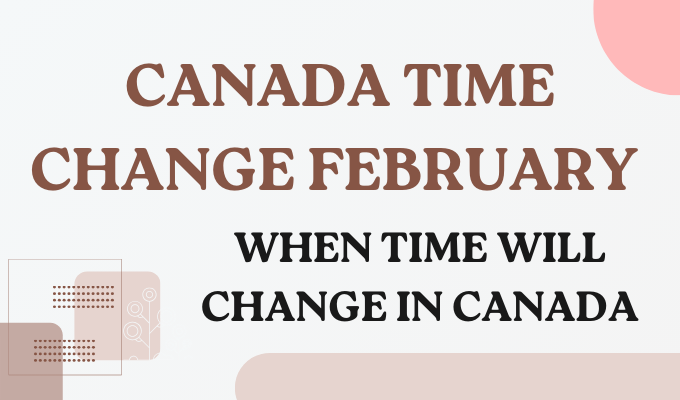You must stay on our portal to read and know in detail about Canada Time Change February 2024: When Time will Change in Canada (Daylight Saving).
Canada Time Change February 2024
Canada Time change refers to the custom of springing an hour forward and fallbacking an hour in the clock. Starting daylight an hour later in the morning is intended to maximize daylight utilization into the evening.
With the exception of a few isolated areas in British Columbia and parts of Saskatchewan, the majority of Canada observes Canada Time Change. Interestingly, Time Change lasts about 34 weeks (238 days) a year in Canada, which is over 65% of the year.
|
Important Links |
You must continue reading this post to get to know in detail about Canada Time Change February 2024, and understand its specifics in a better manner.
Understanding Canada Time Change
The process known as Canada Time Change, or Daylight Saving Time, involves moving clocks one hour forward of Standard Time in the summer and back again in the fall. Our summer nights are brighter when the clocks are moved forward one hour in the spring, and our winter mornings are brighter when they are rolled back one hour in the fall.

Whether or not to utilize DST depends on local regulations in each Canadian municipality. The DST schedule of certain provinces and territories is thus not followed in certain places. Hence, Nine out of 10 provinces and two of the three territories in Canada observe daylight saving time (DST), with some provinces and Nunavut making exceptions.
From 1908 to 2024, Canada observed Daylight Saving Time. The main idea is that this enables us all to utilize natural daylight more effectively. DST is criticized by many, and for good reason!
Canada Time Change February Overview
| Article Name | Canada Time Change February 2024 |
| Observed In | Canada and America |
| Total Observing Canadian Provinces | 9 provinces |
| Starting Year | 1908 |
| Canada Time Change Date | 2 a.m. EST on Sunday, March 10 to a.m. EST on Sunday, November 3 |
| Complete Information | Get Here |
When Time will Change in Canada (Daylight Saving) 2024?
Every year on the second Sunday in March and the first Sunday in November, Daylight Saving Time is observed. In 2024, “fall back” will occur at 2 a.m. EST on Sunday, November 3, while “spring forward” will occur at 2 a.m. EST on Sunday, March 10.
To “spring forward,” clocks are moved forward by one hour on Saturday night, meaning that one hour is lost. March 10, 2024, will see sunrise and sunset around one hour later than the previous day. It will get lighter in the evening. Clocks are turned back one hour on Saturday night in order to “fall back.” November 3, 2024, will have sunrise and sunset around one hour earlier than the previous day. The dawn will bring with it greater light.
Historically, daylight saving time was observed from late February until late October. The current versions, which are in effect for March and November, were altered in the middle to late 2000s.
Canada Time Change History
The first documented idea to “save” daylight dates back to 1784 and was proposed by Benjamin Franklin in “An Economical Project.” Advocating legislation forcing individuals to get up early in order to save money on candles, it had a comical tone. But an Englishman by the name of William Willet, who put up the concept in 1907, was the first real proponent of Daylight Saving Time.
|
Important Links |
The first Daylight Saving Time was observed in Canada in 1908. The first day of daylight saving time (DST) was observed by the people of Port Arthur, Ontario, which is now Thunder Bay, on July 1, 1908. Other Canadian communities quickly adopted a similar approach. Regina, Saskatchewan, instituted DST on April 23, 1914. In Manitoba, on April 24, 1916, the cities of Winnipeg and Brandon did likewise.
Final Words
All indications are that twice-yearly clock adjustments will continue, even though many Canadians dislike having to “spring forward” and “fall back” every year. Clocks will advance once more on Sunday, March 10, as no significant legislation pertaining to daylight saving time (DST) was passed in 2023.
When the time changes, a lot of individuals find it difficult to recall which direction the clock goes. Recalling the mantra “spring forward, fall back” is one simple method. Additionally for your update, Daylight Saving Time will begin at two a.m. EST on Sunday, March 9 for “spring forward” and two a.m. EST on Sunday, November 2, for “fall back.”
Many thanks for reading this page about the February 2024 change in Canada Time. Please return to our site for more up-to-date and fascinating topics.